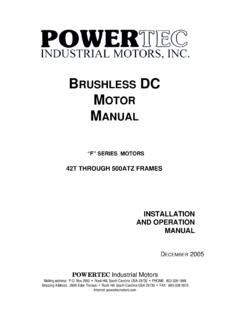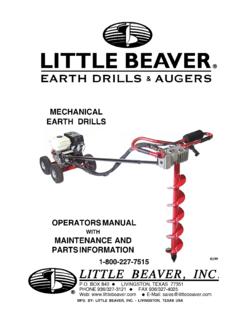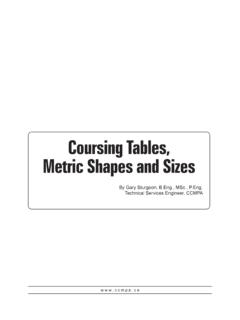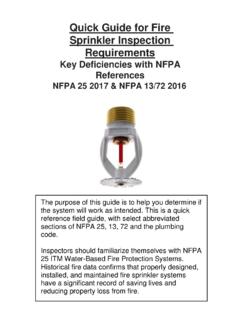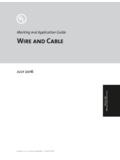Transcription of TYPICAL APPLICATIONS - PowerTEC Industrial Motors
1 74 TYPICAL APPLICATIONSTYPICAL APPLICATIONSCONVERTING AND PRINTINGS heeter5-20A machine used to feed a continuous web ofpaper into a cutter, cutting it to length. Inverse ratio -- calibrated to sheet length, 1/64" Master/slave control Regen operationMATERIAL HANDLINGL owerator20-125 Used to handle logs or rolls of them from a higher to lower level. Very good torque and speed control Handles high peak and rms loads Precise stopping requires precise accel/decel rates High torque/inertia ratio motorsShuttle Car10-30 Large, heavy car that runs on tracks, capableof carrying 40,000 pounds or more.
2 Hastraverse conveyors for moving product. Capable of handling line voids 4-quadrant regen Handles high peak and rms loads Rugged motor constructionPLASTICSE xtruder40-300 High efficiency Low maintenance Good low speed torqueCo-Extrusion5-150A series of extruders putting material atvery exact proportions into the same die. Good speed (ratio) stability Good ratio and following controlCrammer/5-30 FeederA device used to cram material into theextruder throat, rather than use a gravityfeed. TENV enclosure required because of the dusty environment Good low speed torque Needs torque control (torque limited, speed controlled), PVC manufacturingPullers2-15A set of friction rollers used to pull material out of anextruder die at a precise rate, to assure constant cross-sectional dimension.
3 The wall thickness can becontrolled or changed by pulling at precise rates. TENV enclosure Accurate ratio controlFilm with a film die, either circular (blown film) orflat (cast film) and appropriate downstream equipment. TENV enclosure Accurate ratio controlBlow Molding 20-250 Blow molding takes an extruded hollow piece of plasticmaterial, called a parison, then closes a mold around itand injects air into it to blow the material into theshape of the mold. Used to produce hollow shapes. High torque Continuous operation High efficiencyInjection 2-100 MoldingInjection molding injects the plastic materialdirectly into a mold under high pressure, without blowing it.
4 Used to produce solid shapes. The extruder on an injection molding press istypically hydraulic, due to the pressures used, butother drives need to have the position control and fastresponse and cycle times of a servo-type auger that also accomplishes shear heating andmixing of thermo-plastic material. Horsepowerrequirement roughly correlates to feed screw common plastics Handling Belt feeders Reciprocating feedersPaper Planers Dryers Converting machines Beaters/Pulpers Slab conveyors ChoppersMachine Tool Bending rolls Punch presses Tapping machineryMetal Forming/Rolling Draw bench carriages Slitters Extruders Reel drives Rod drives Edger drivesRubber Industry Extruders Tire-building machines Mixing millsMarket Segment Approx DescriptionRequirements& ApplicationHP RangeOther MarketSegments andApplications
5 Toconsider: TYPICAL APPLICATIONS (CON'T)TEST STANDSD rive Shafts30-200 Prime mover motor and load motor forapplying forward or reverse speed andtorque on drive shafts and CV joints. High speed High horsepower Broad, constant power rangeHydraulic 5-400 PumpsA prime mover motor to turn the pumpunder test and a load motor to load ahydraulic motor under load. High efficiency Good bandwidth (fast response) Ability to handle very sharply applied loads Common bus is a huge advantage Wide range of torque and speedJet Fuel 5-50 PumpPrime mover motor for hydraulicpump that simulates a jet engine.
6 Class I, Div. 2 or Div. 1 hazardous location ratings High speed High accuracy over broad range of rapidly changing loadsTwin 50-150 OutdrivePrime mover motor and two load Motors tosimulate a driving engine and two counter-rotating propellers. Common bus for efficiency Efficient power regeneration Good speed and torque control in all directionsTEXTILESRide-Through 40+Generator Efficient no-load operation Line-loss sensing scheme Controlled DC (spinning) a thread to orient the material andthereby increase the strength.
7 Usually associated with man-made thread, which is extruded through a multi-hole die. Very precise ratio control Synchronous operation of multiple drivesWarper/30-125 BeamerA winder that winds parallel threads onto a cylindricaldrum (beam) for use later in a weaving loom. TENV or TEAO enclosures required because of lint Very good bandwidth (response time) Torque control if no dancer is used Quick stoppingDraw 30-125 WarpingA single machine doing both drawing(spinning) and warping in one operation. Needs a sophisticated drive system, with extremely good control -- down to zero speed High bandwidth Good power ride-through Needs frequency reference and feedbackThis is a regen drive connected via a common bus to otherPacific Scientific drives.
8 It uses flywheel energy to keepproduction lines running through short power 1-10 Full 4-quadrant operation Ability to be pulled backward or forward from zero speed Good torque and speed (Torque)This is a winder with a levelwind or traversingmechanism. It is usually mechanical. Most take-upsare simple tension/torque devices Economical Rugged construction Torque or dancer controlTwister/Up to 30 CablerCombines a number of small gauge wiresinto a group (cable). Precise ratio control Synchronous following at 1:1A place to keep the product while a downstreamprocess is stopped, so the need to stop allprocesses is APPLICATIONS (CON'T)Market Segment Approx DescriptionRequirements& ApplicationHP Range76 MOTOR PERFORMANCE CURVESThe specification section of this selection guide shows themotor ratings, characteristics, torque/speed curves,power/speed curves, and efficiency profiles for standardmotors.
9 Performance characteristics can be customized forspecific CURVES Figure 1 shows a TYPICAL torque/speed curve, along with itsrated torque, speed, and current parameters, from the"Performance Curves" section of this selection guide. Thecurves represent TYPICAL motor performance when driven by abrushless motor drive with a 640V dc bus, a sinusoidal currentoutput, and continuous and peak current capabilities to matchthe motor ratings in the table. Note that the curve shows bothcontinuous and intermittent duty areas of 1: E184E1 DPBV performance curve and tableFigure 1 CONTINUOUS DUTY AREAThe motor may be operated at any speed and torque withinthe continuous duty area for any length of time.
10 The area isbordered by the continuous torque output line and themaximum speed continuous torque line represents the maximum torquethe motor can produce continuously at different speedswithout exceeding the rated winding temperature of 140 C in a40 C ambient (See "Ambient Temperature Derating", page70). It is a function of the motor s maximum speed line represents the maximum speedthe motor can reach at different loads. It is a function of thebus voltage of the drive (640V dc for these curves) and themotor winding. Different windings may produce highermaximum speeds, but at the expense of higher currentrequired to produce a given DUTY AREAThe motor may be operated at any speed and torque withinthe intermittent duty area for shorter lengths of time.


